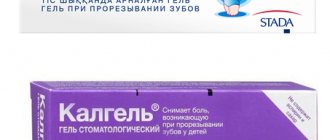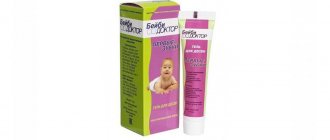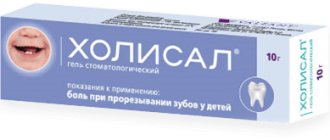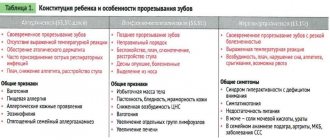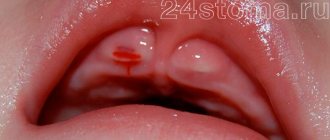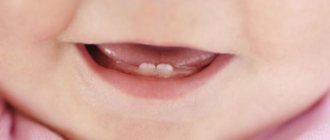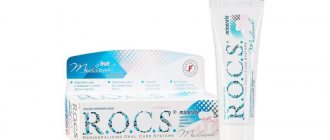Teething is a difficult period for babies and their parents. The process is accompanied by the baby crying, being capricious and refusing to eat. To relieve symptoms, pediatricians prescribe Kalgel for children's teeth.
The product is also used as part of complex therapy for dental diseases in children and adults (stomatitis, gingivitis). This is explained by the complex effect of the active components of the drug on the mucous membranes of the mouth. The composition of the gel and instructions for use must be studied in more detail before the first application.
Description of the drug
Kalgel is available only in the form of a dental gel. The drug has a uniform thick consistency, without inclusions, dark yellow color and a specific odor.
1 g of gel contains 3.3 mg of lidocaine hydrochloride and 1 mg of cetylpyridinium chloride. Additionally, there is a solution of sorbitol, ethanol, glycerol, citric acid monohydrate, macrogol, xylitol, levomenthol, saccharinate and sodium citrate, flavorings and water.
The gel is packaged in 10 g aluminum tubes. Sold in cardboard boxes complete with instructions. Produced in Poland.
Shelf life of Kalgel
The shelf life of the dental gel is 3 years from the date of release. After opening the tube, the shelf life of the medicine does not change.
The date of manufacture is indicated on the cardboard packaging - the medicine must be used before the expiration date.
Kalgel should be stored at room temperature, which will not lead to changes in the therapeutic effect. Storing the drug in the refrigerator will also not affect its properties.
Using the medicine 5-10 days before the expiration date is not prohibited, since it can retain its properties for several months after the expiration date.
Over time, or if stored improperly, the medicine may deteriorate. If it was initially stated that Kalgel has a yellowish-brown color, the consistency of the drug is uniform, without foreign inclusions of grains and particles, then after the expiration date the gel may turn into a clear liquid or dry out completely.
The use of a drug that has changed its consistency is strictly prohibited, the same applies to drugs that have expired.
Therapeutic effects of Kalgel
According to the instructions, Kalgel is a combination product that has an antimicrobial effect on the oral mucosa and also has a local analgesic effect.
The mechanism of action is determined by the properties of the main active substances included in it.
Lidocaine hydrochloride inhibits nerve conduction by blocking sodium channels, and therefore has a local anesthetic effect.
Cetylpyridinium chloride belongs to the group of antiseptics that suppress the proliferation of pathogenic microflora in the oral cavity.
Kalgel
Kalgel (lidocaine + cetylpyridinium chloride) is a drug for local anesthesia in dentistry. To realize its anesthetic effect, it is applied to the oral mucosa. Lidocaine is a local anesthetic. It is quickly absorbed from the site of application and enters the blood, where it interacts with plasma proteins. Rapidly undergoes metabolic transformations in the liver. Excreted along with urine. Cetylpyridinium chloride is a disinfectant. It is absorbed to a small extent in the oral mucosa. Kalgel is used to quickly eliminate pain during teething and prevent irritation (hyperemia, swelling) of the gums. It is used in pediatric practice after the child reaches three months of age. A single dose is about 7.5 mm of gel. Application and subsequent rubbing of the drug into the inflamed gums is done with the tip of your finger (before squeezing the required amount of gel onto your finger, you must wash your hands thoroughly). Repeated application is possible after 20 minutes, and the frequency of use of Kalgel should not exceed 6 times a day. If you strictly follow the instructions, the risk of developing any unwanted side reactions is minimal. In rare cases, after local injections, episodes of hypersensitivity to one of the active components of the drug, lidocaine, were recorded.
Manifestations of hypersensitivity - skin rashes, local swelling, slight difficulty breathing. Kalgel's herbal flavor contains chamomile, which can cause allergies in people predisposed to atopy. Cases of allergic reactions due to the consumption of herbal teas, which included chamomile, have been documented. If adverse reactions develop, you should stop using the drug and seek medical advice. Kalgel contains fructose, so the drug is contraindicated in persons with genetically determined fructose intolerance. The drug is contraindicated during pregnancy and breastfeeding (its effect in this category of patients has not been studied). If the recommended doses or frequency of use of Kalgel is exceeded, a decrease in the sensitivity of taste and temperature receptors located in the pharynx and oral cavity may develop. A similar case was described in a man who, while gargling, accidentally swallowed approximately 100 mg of lidocaine, which is equivalent to 5.5 g of Calgel gel. It should be noted that even if the recommended doses are significantly exceeded, the likelihood that toxic concentrations of lidocaine or cetylpyridinium chloride will be achieved is extremely low. The pharmacological interaction of Kalgel with other drugs has not been studied.
Contraindications for using Kalgel
The gel is not prescribed for hypersensitivity to lidocaine or cetylpyridinium chloride, as well as to other components of the drug.
Also contraindicated are:
- low blood pressure (pressure not higher than 100/60 mm Hg);
- serious impairment of all liver or kidney functions;
- heart failure syndrome grade 2-3;
- arrhythmia, which is characterized by a decrease in heart rate to 60 beats per minute and below;
- cardiac pathology associated with slowing or blocking the passage of impulses through the ventricles.
Rules for storing Kalgel in pharmacies and clinics
In pharmacies and clinics, Kalgel should be stored in special refrigerators designed for storing this type of medicine. Here they are kept both for treatment and for sale.
Disposal is provided when a spoiled or expired medication is identified. According to the standards prescribed in GOST 17768-90, only employees of companies that have official permission from the city or local administration, and also if they have the necessary equipment, can destroy medical supplies.
Transportation is also carried out in accordance with GOST - in vehicles equipped with special refrigerators.
Reviews
On the Internet you can find polar opinions from experts about Kalgel. Some pediatricians consider the gel unsafe due to the presence of lidocaine. The effect is short-lived, since the drug is washed off with saliva. The other part speaks extremely positively about the gel, emphasizing its effectiveness, pleasant taste and ease of use, including for stomatitis in children. After application there is no unpleasant sensation in the form of burning or tingling, the analgesic effect occurs quite quickly.
Parents also have mixed reviews of the gel. Most note that the drug helped with painful teething. Due to excessive salivation, the effect of use is short-lived. Not all parents like the fact that it is necessary to smear swollen gums with gel, the touch of which is painful. Among the disadvantages is the high price of the medicine.
How to store Kalgel at home
After purchase, Kalgel should be stored out of the reach of children at a temperature not exceeding +25 °C.
It is best to store the drug in a place where there are no sudden changes in temperature and high humidity.
The medicine should be stored in its original container , since when moved to another container, it may dry out and be unsuitable for use.
Also, do not store medications in the bathroom or kitchen, where there is such a risk. For this dosage form, there is no fundamental difference whether the drug is stored at room temperature or in the refrigerator. Both options are acceptable. However, you should not place Kalgel close to the freezer, otherwise the medication may freeze.
Analogues:
- Kamistad
- Dentinox
- Dentol baby
Side effects
Most often, after applying Kalgel, children experience allergic reactions in the form of urticaria, dermatitis and eczema. Quincke's edema is less common. The last symptom is a reason to call emergency help. Otherwise, the child may suffocate.
To avoid unpleasant symptoms from drug treatment, before using Kalgel for a child, parents should first consult with a pediatrician
Among the signs of a drug overdose, the following should be noted:
- difficulty breathing;
- bradycardia;
- pale skin;
- vomiting;
- nausea.
Instructions for use
Typically, the eruption of the first elements is accompanied by pain and swelling of the gums in children. At the same time, the baby refuses to eat from a bottle and constantly puts foreign objects and fingers in his mouth, thus trying to reduce the discomfort.
To alleviate the symptoms of the condition, Kalgel is applied to the inflamed gum tubercle during teething. Before using the drug, parents should not pre-prepare the mucous membranes. Take a small amount of gel (the size of a pea) onto your index finger and apply it with a gentle massaging motion to the problem area of the baby’s gums. Instead of a finger, you can use a sterile gauze swab or a cotton swab.
During the period of active eruption of elements on the surface of the gums, it is allowed to use the product 3 to 6 times. After the acute symptoms of the condition disappear, the number of uses of the drug is reduced to 4 times. It is important that at least 30 minutes pass between successive gum treatment procedures. This rule prevents the development of negative consequences during drug treatment.
Use for stomatitis
Stomatitis is a frequently diagnosed disease in preschool children. Pathology appears in children due to the immaturity of the immune system and bad habits of putting foreign objects into the mouth.
The main cause of stomatitis is the Candida fungus, which is present in the saliva of almost every person. It is classified as a group of opportunistic microorganisms, because it is activated only in the presence of favorable factors (stress, decreased immunity, non-compliance with personal hygiene rules)
Before using Kalgel for stomatitis in children, the mucous membranes of the mouth are cleaned of white plaque using a gauze swab dipped in hydrogen peroxide or another antiseptic. The surface of the tongue, the inside of the cheeks and gums are treated. After the preparatory procedure, a small amount of Kalgel is applied to the affected areas using a finger or a cotton swab. The frequency of the procedure is at least 3 times a day.
Use for gingivitis
Adults are more likely to experience gingivitis than stomatitis. The disease is accompanied by severe inflammation of the gums and can provoke other, more dangerous, dental disorders (periodontitis, periodontal disease, tooth loss).
Kalgel for gingivitis allows you to quickly relieve the symptoms of inflammation and stop the proliferation of pathogenic flora. Before using the medicine, it is advisable to rinse your mouth with antiseptic solutions (Chlorophyllipt, Rotokan, Chlorhexidine). The anesthetic is gently rubbed into the areas of inflammation, trying to avoid bleeding. In case of severe inflammation, the mouth is pre-treated with hydrogen peroxide.
Properties
Kalgel is distinguished by its combined action. Thanks to this, it can have several effects on problem areas of the oral mucosa at once. The gel quickly relieves symptoms characteristic of dental disorders.
Effects provided by the gel:
- Analgesic. This is achieved thanks to the anesthetic contained in the product. It is worth noting that the analgesic effect of the medication does not last long.
- Antimicrobial. The product inhibits the proliferation of pathogenic flora in the mouth, thereby preventing the development of complications against the background of the inflammatory process.
- Anti-inflammatory. The drug relieves the feeling of itching and the intensity of inflammation a few minutes after applying the gel to the gums. The condition of the babies quickly improves after applying the product.
The effect of Kalgel lasts for 2–3 hours. After this, the child will again be capricious and scratch his gums.
Indications and contraindications for use
Kalgel is used in the following cases:
- when the first teeth erupt in babies;
- eliminating signs of stomatitis, gingivitis and glossitis;
- appearance of wisdom teeth on the gum surface;
- inflammatory diseases of periodontal tissues.
Clinically, the effectiveness of the drug against inflammatory gum diseases in the acute stage of the course, accompanied by severe pain, was revealed. The rapid anesthetic effect is explained by the presence of lidocaine in the structure of the drug.
The main contraindication for the use of the medicine is the presence of allergic reactions to its components, manifested by difficulty breathing and the formation of a rash on the body. It is advisable to conduct allergy tests on the child before using the product for the first time. To do this, apply a small amount of the product to the elbow bend and evaluate the skin reaction after 15 minutes. Apply the gel to the baby's gums only if there is no redness or rash on the test area.
An allergy test is mandatory when using Kalgel for the first time, since adverse reactions in infants are much more severe than in adults. If allergy symptoms appear, the child should be immediately shown to the pediatrician.
In addition, there are other contraindications to the use of topical medications:
- children under three months of age;
- renal and liver failure;
- bradycardia;
- arterial hypotension;
- heart failure.
A relative contraindication to the use of the product is during pregnancy. The gel is allowed to be used only if its benefits to the mother are higher than the potential risks to the unborn child.
Customer Reviews
Pauline. A few months ago I encountered the problem of bleeding gums. Added to this problem was a wisdom tooth, which erupted very painfully. I read reviews on the Internet and decided to try Kalgel to combat my problem. After the first application, the pain disappeared within 30 minutes, which pleasantly surprised me. I used the gel 2 times a day until the wisdom tooth erupted completely. I was pleased with the results of using Kalgel. The only drawback of the drug is its cost (about 280 rubles per 10 mg tube).
Natalia. My daughter had a very hard time getting her first baby teeth out. For several nights she could not sleep normally, and during the day she refused to eat. The pharmacy recommended that I buy Kalgel. I used it 3 times a day and noticed an improvement in my daughter’s well-being. She gained an appetite and slept better. Together with Kalgel I gave my daughter Nurofen. So we survived a difficult time for us.
Larisa. Our child's teething did not always go smoothly. Once, my husband had to run in the middle of the night to get painkillers because his son couldn’t sleep. The drug cost us 300 rubles, but we did not regret buying it.
Composition and release form
The main active component in the structure of the drug is lidocaine (3.3 g). A local antiseptic affects only problem areas of the mucous membranes, without spreading to neighboring tissues. The analgesic effect is achieved by blocking sodium channels, which helps eliminate discomfort in the short term.
Another active substance in Kalgel is cetylpyridinium chloride (1 mg) - an antiseptic that prevents the active reproduction of pathogenic microorganisms.
Additional substances in Kalgel:
Viburkol suppositories for teething children
- xylitol – 140 mg;
- sorbitol – 210 mg;
- macrogol – 3.3 mg;
- glycerol – 70 mg,
- sodium saccharide – 1 mg;
- hyaetellose – 25 mg;
- levomenthol – 0.6 mg;
- citric acid – 1 mg;
- ethanol – 93.6.
In addition to the listed components, the gel structure also includes purified water and herbal flavors. The medicine is produced in aluminum tubes of 10 g.
The color of the gel is light brown, without any foreign impurities. It does not contain a strong taste or smell, so children are not capricious when using it during teething.
